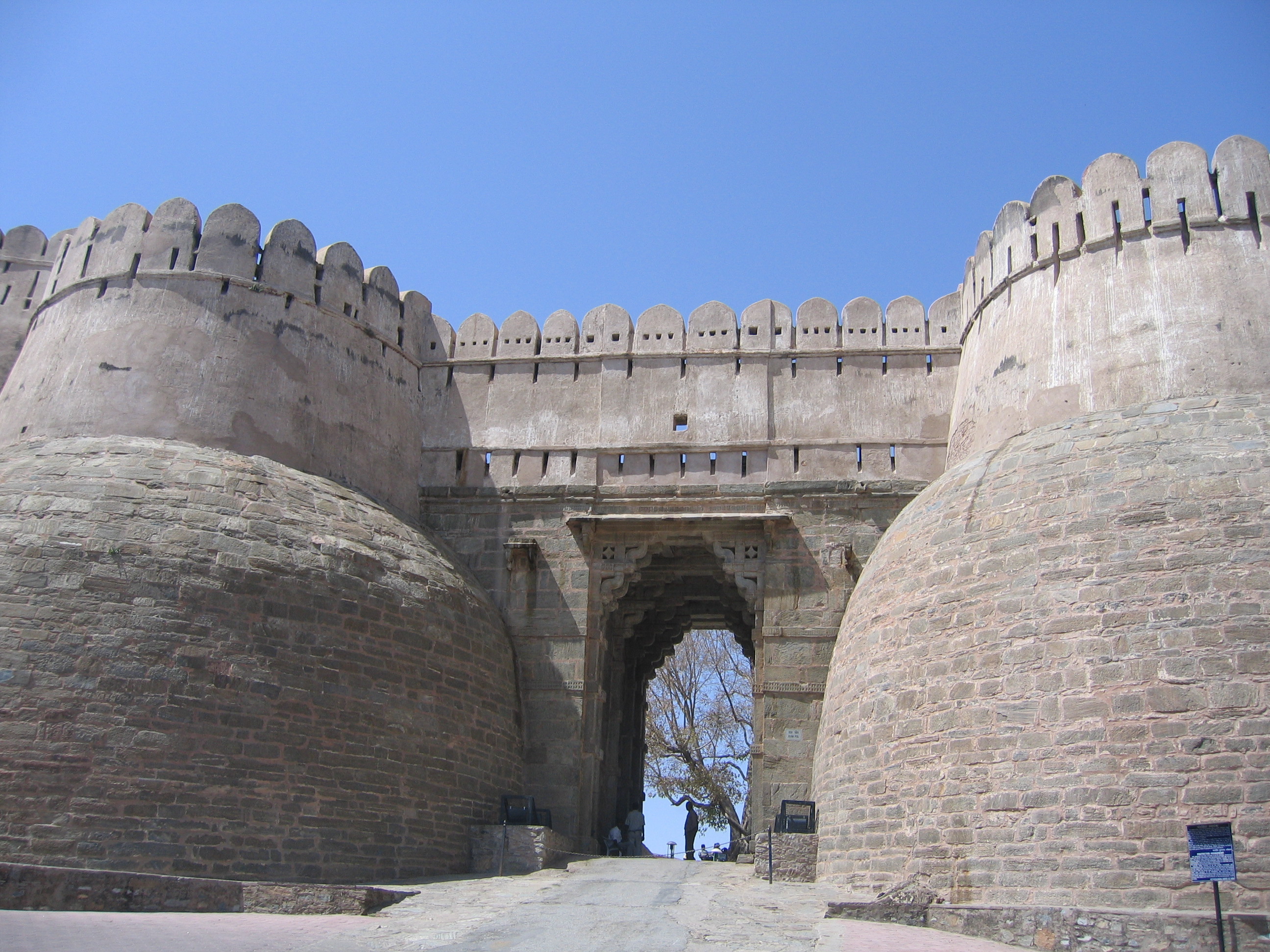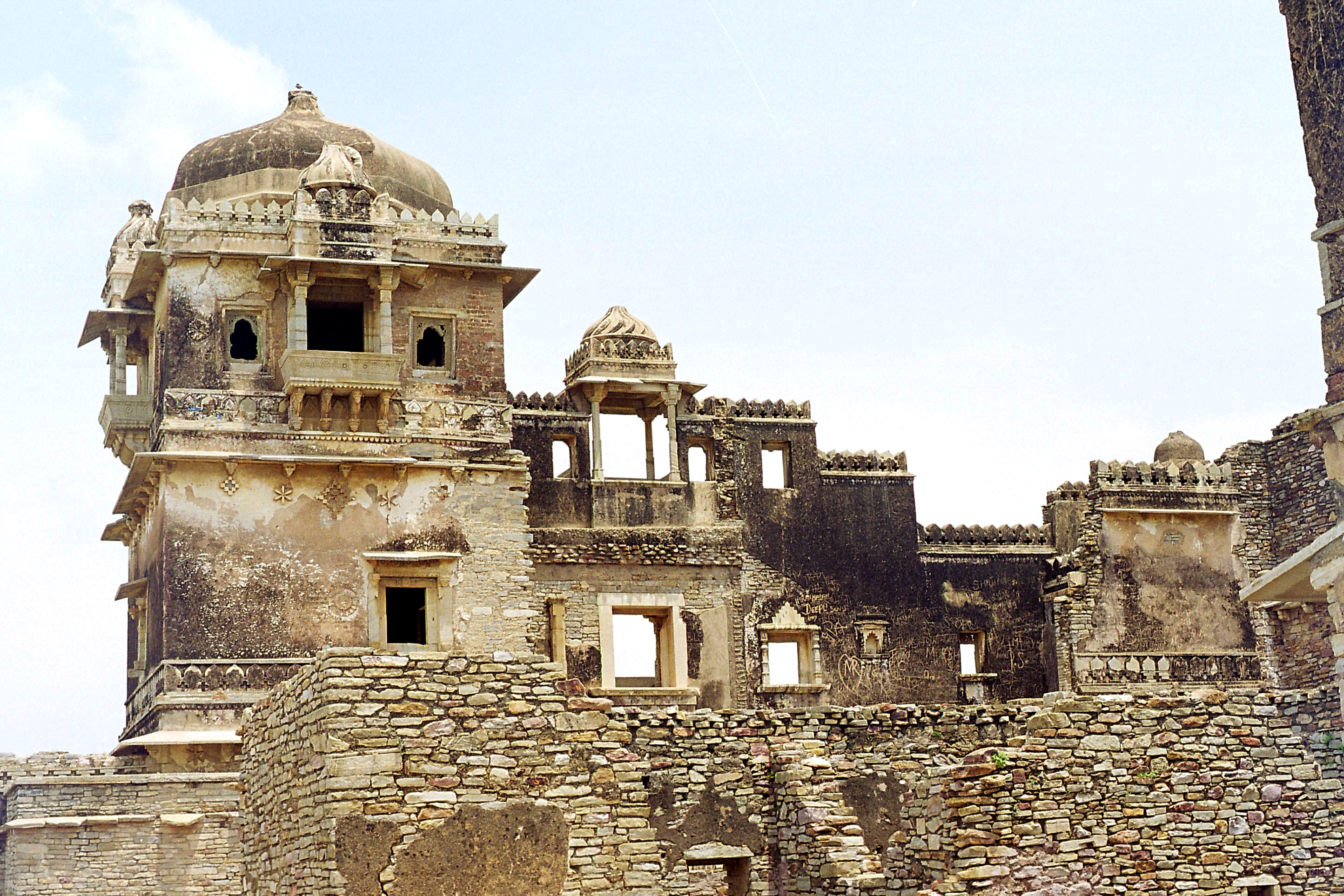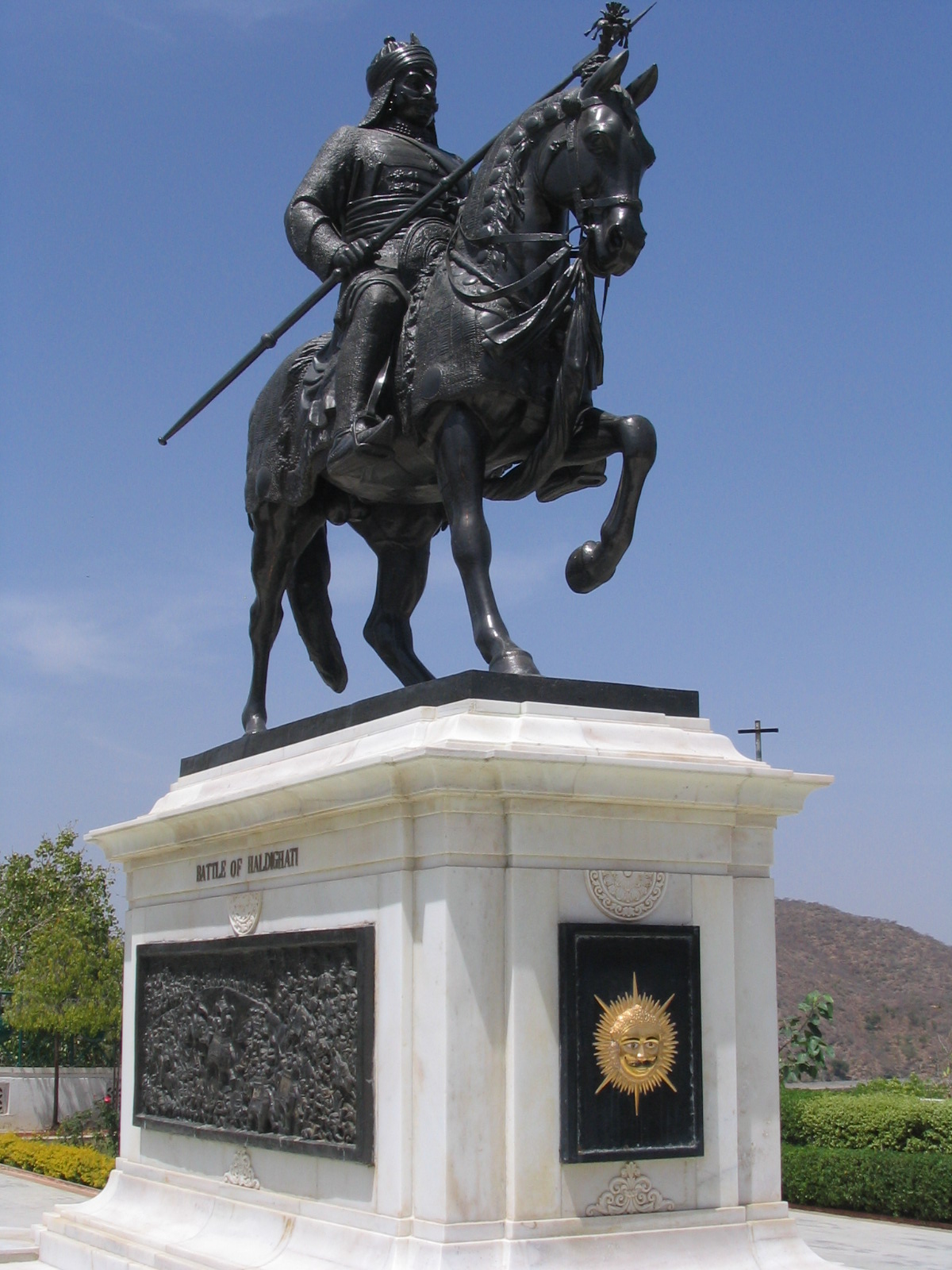|
Kumbhalgarh
Kumbhalgarh (literally "Kumbhal fort") also known as the Great Wall of India is a Mewar fortress on the westerly range of Aravalli Hills, just about 48 km from Rajsamand city in the Rajsamand district of the Rajasthan state in western India. It is located about 84 km from Udaipur. It is a World Heritage Site included in Hill Forts of Rajasthan. It was built during the 15th century by Rana Kumbha. In 2013, at the 37th session of the World Heritage Committee held in Phnom Penh, Cambodia, Kumbhalgarh Fort, along with five other forts of Rajasthan, was declared a UNESCO World Heritage Site under the group Hill Forts of Rajasthan. The chief architect who built this fort was Mandan, who documented his style of work in his text, Rajvallabh. The fort is among the largest fort complexes in the world. History The early history of the fort could not be ascertained on account of lack of evidence. Before Rana Kumbha built the new fort, there was a small fort, limited to small hilly are ... [...More Info...] [...Related Items...] OR: [Wikipedia] [Google] [Baidu] |
Hill Forts Of Rajasthan
The North Western Indian State of Rajasthan has over one hundred fortifications on hills and mountainous terrain. Six Hill Forts of Rajasthan, spread across Rajasthan state in northern India, have been clustered as a series and designated UNESCO World Heritage Site. The ‘Hill Forts of Rajasthan’ was initially submitted to the UNESCO as a serial property formed by five Rajput forts in the Aravalli Range, and were built and enhanced between the 5th and 18th centuries CE by several Rajput kings of different kingdoms. The UNESCO series has been increased to six forts. They consist of: # Chittor Fort at Chittorgarh city # Kumbhalgarh Fort at Rajsamand city # Ranthambore Fort at Sawai Madhopur # Gagron Fort at Jhalawar city # Amer Fort at Jaipur city # Jaisalmer Fort at Jaisalmer city Some of these forts have defensive fortification wall up to 20 km long, still surviving urban centers and still in use water harvesting mechanism. Selection A series was to be selected a ... [...More Info...] [...Related Items...] OR: [Wikipedia] [Google] [Baidu] |
Rajsamand District
Rajsamand District is a district of the state of Rajasthan in western India. The city of Rajsamand is the district headquarters. The district was constituted on 10 April 1991 from Udaipur district by carving out 7 tehsils - Bhim, Deogarh, Amet, Kumbhalgarh, Rajsamand, Nathdwara, and Railmagra. Geography The district has an area of 4,768 km2. The Aravalli Range forms the northwestern boundary of the district, across which lies Pali District. Ajmer District lies to the north, Bhilwara District to the northeast and east, Chittorgarh District to the southeast, and Udaipur District to the south. The district lies in the watershed of the Banas River and its tributaries. Some other rivers are: Ari, Gomati, Chandra and Bhoga. Demographics According to the 2011 census Rajsamand district has a population of 1,156,597, roughly equal to the nation of Timor-Leste or the US state of Rhode Island. This gives it a ranking of 405th in India (out of a total of 640). The district h ... [...More Info...] [...Related Items...] OR: [Wikipedia] [Google] [Baidu] |
Rana Kumbha
Kumbhakarna Singh (r. 1433–1468 CE), popularly known as Maharana Kumbha, was the Maharana of Mewar kingdom in India. He belonged to the Sisodia clan of Rajputs. Rana Kumbha is known for his illustrious military career against various sultanates and patronization of art and music and architecture. Early life Rana Kumbha was born at Madariya, in a Hindu Rajput family of Sisodia clan. Kumbha was a son of Rana Mokal Singh of Mewar by his wife, Sobhagya Devi, a daughter of Jaitmal Sankhla, the Paramara fief-holder of Runkot in the state of Marwar. He was the 48th Rana of Mewar and succeeded Rana Mokal Singh in the year 1433 CE as the ruler of Mewar. Early period After being overrun by the armies of Alauddin Khalji at the turn of the 13th century, Mewar had become relatively insignificant. Rana Hammira is credited with casting off the Turkic yoke and establishing the second Guhila dynasty of Chittor in 1335. The title ''Rana'', and later ''Maharana'', were used by rulers of ... [...More Info...] [...Related Items...] OR: [Wikipedia] [Google] [Baidu] |
Udai Singh II
Udai Singh II (4 August 1522 – 28 February 1572) was the Maharana of Mewar and the founder of the city of Udaipur in the present-day Rajasthan state of India. He was the 12th ruler of the Kingdom of Mewar. He was the fourth son of Rana SangaTod, James (1829, reprint 2002). ''Annals & Antiquities of Rajasthan'', Vol.I, Rupa, New Delhi, , p.240-52 and Rani Karnavati, a princess of Bundi. Early life Udai Singh was born in Chittor in August 1522. After the death of his father, Rana Sanga, Ratan Singh II was crowned King. Ratan Singh II was assassinated in 1531. He was succeeded by his brother Maharana Vikramaditya Singh. During the reign of Vikramaditya, when the Muzaffarid Sultan of Gujarat Bahadur Shah sacked Chittor in 1535, Udai Singh was sent to Bundi for safety. In 1537, Banvir killed Vikramaditya and usurped the throne. He tried to kill Udai Singh as well, but Udai's nurse Panna Dai sacrificed her own son Chandan to save him from his uncle Banvir and took him to Kumbh ... [...More Info...] [...Related Items...] OR: [Wikipedia] [Google] [Baidu] |
Udaipur
Udaipur () (ISO 15919: ''Udayapura''), historically named as Udayapura, is a city and municipal corporation in Udaipur district of the state of Rajasthan, India. It is the administrative headquarter of Udaipur district. It is the historic capital of the kingdom of Mewar in the former Rajputana Agency. It was founded in 1559 by Udai Singh II of the Sisodia clan of Rajput, when he shifted his capital from the city of Chittorgarh to Udaipur after Chittorgarh was besieged by Akbar. It remained as the capital city till 1818 when it became a British princely state, and thereafter the Mewar province became a part of Rajasthan when India gained independence in 1947. The city is located in the southernmost part of Rajasthan, near the Gujarat border. It is surrounded by the Aravali Range, which separates it from the Thar Desert. It is placed almost in the middle of two major Indian metro cities, around 660 km from Delhi and 800 km from Mumbai. Besides, connectivity with Gujar ... [...More Info...] [...Related Items...] OR: [Wikipedia] [Google] [Baidu] |
Maharana Pratap
Pratap Singh I, popularly known as Maharana Pratap (c. 9 May 1540 – 19 January 1597), was a king of Mewar from the Sisodia dynasty. Pratap became a folk hero for his military resistance against the expansionism of the Mughal Empire under Akbar through guerrilla warfare which proved inspirational for later rebels against Mughals including Shivaji. Early life and accession Maharana Pratap was born to Udai Singh II of Mewar and Jaiwanta Bai. His younger brothers were Shakti Singh, Vikram Singh and Jagmal Singh. Pratap also had 2 stepsisters: Chand Kanwar and Man Kanwar. He was married to Ajabde Punwar of Bijolia and he had married 10 other women and was survived by 17 sons and 5 daughters including Amar Singh I. He belonged to the Royal Family of Mewar. After the death of Udai Singh in 1572, Rani Dheer Bai wanted her son Jagmal to succeed him but senior courtiers preferred Pratap, as the eldest son, to be their king. The desire of the nobles prevailed. Udai Singh died in ... [...More Info...] [...Related Items...] OR: [Wikipedia] [Google] [Baidu] |
Mewar
Mewar or Mewad is a region in the south-central part of Rajasthan state of India. It includes the present-day districts of Bhilwara, Chittorgarh, Pratapgarh, Rajsamand, Udaipur, Pirawa Tehsil of Jhalawar District of Rajasthan, Neemuch and Mandsaur of Madhya Pradesh and some parts of Gujarat. For centuries, the region was ruled by Rajputs. The princely state of Udaipur emerged as an administrative unit during the period of British East India Company governance in India and remained until the end of the British Raj era. The Mewar region lies between the Aravali Range to the northwest, Ajmer to the north, Gujarat and the Vagad region of Rajasthan to the south, the Malwa region of Madhya Pradesh state to the south and the Hadoti region of Rajasthan to the east. Etymology The word "Mewar" is vernacular form of "Medapata" ( IAST: Medapāṭa), the ancient name of the region. The earliest epigraph that mentions the word "Medapata" is a 996–997 CE (1053 VS) inscription discovered ... [...More Info...] [...Related Items...] OR: [Wikipedia] [Google] [Baidu] |
Rajasthan
Rajasthan (; lit. 'Land of Kings') is a state in northern India. It covers or 10.4 per cent of India's total geographical area. It is the largest Indian state by area and the seventh largest by population. It is on India's northwestern side, where it comprises most of the wide and inhospitable Thar Desert (also known as the Great Indian Desert) and shares a border with the Pakistani provinces of Punjab to the northwest and Sindh to the west, along the Sutlej- Indus River valley. It is bordered by five other Indian states: Punjab to the north; Haryana and Uttar Pradesh to the northeast; Madhya Pradesh to the southeast; and Gujarat to the southwest. Its geographical location is 23.3 to 30.12 North latitude and 69.30 to 78.17 East longitude, with the Tropic of Cancer passing through its southernmost tip. Its major features include the ruins of the Indus Valley civilisation at Kalibangan and Balathal, the Dilwara Temples, a Jain pilgrimage site at Rajasthan's only hill stat ... [...More Info...] [...Related Items...] OR: [Wikipedia] [Google] [Baidu] |
Chittor
Chittorgarh (also Chittor or Chittaurgarh) is a major city in Rajasthan state of western India. It lies on the Berach River, a tributary of the Banas, and is the administrative headquarters of Chittorgarh District. It was a major stronghold of the Rajput State of Medapata. (modern Mewar) The city of Chittorgarh is located on the banks of river Gambhiri and Berach. Chittorgarh is home to the Chittor Fort, the largest fort in India and Asia. It was sacked thrice; first in 1303 by Alauddin Khalji, again in 1535 by Bahadur Shah of Gujarat, and lastly by the Mughal Emperor Akbar in 1568. Its Hindu Rajput rulers fought fiercely to maintain their independence. On all three occasions when faced with a certain defeat, the men fought to death, while the women committed suicide by jauhar (mass self-immolation). Chittor also has been a land of worship for Meera, It is also known for Panna Dai and Rani Padmini. History Originally called Chitrakuta, the Chittor Fort is said to ha ... [...More Info...] [...Related Items...] OR: [Wikipedia] [Google] [Baidu] |
Ranthambore Fort
Ranthambore Fort lies within the Ranthambore National Park, near the city of Sawai Madhopur in Sawai Madhopur district of Rajasthan, India. the park being the former hunting grounds of the Maharajahs of Jaipur until the time of India's Independence. It is a formidable fort having been a focal point of the historical developments of Rajasthan. The fort is believed to be constructed by the Chahamanas. In the 13th century the Delhi Sultanate captured it for a brief time. The fort provides a panoramic view of the surrounding Ranthambore National Park and is now a popular tourist attraction. In 2013, at the 37th session of the World Heritage Committee, Ranthambore Fort, along with 5 other forts of Rajasthan, was declared a UNESCO World Heritage Site under the group Hill Forts of Rajasthan. History The oldest settlement in the area near Sawai Madhopur was around the Ranthambhore fort. The exact origin of the Ranthambore fort is still disputed but it is generally accepted that the ... [...More Info...] [...Related Items...] OR: [Wikipedia] [Google] [Baidu] |
Gwalior
Gwalior() is a major city in the central Indian state of Madhya Pradesh; it lies in northern part of Madhya Pradesh and is one of the Counter-magnet cities. Located south of Delhi, the capital city of India, from Agra and from Bhopal, the state capital, Gwalior occupies a strategic location in the Gird region of India. The historic city and its fortress have been ruled by several historic Indian kingdoms. From the Kachchhapaghatas in the 10th century, Tomars in the 13th century, it was passed on to the Mughal Empire, then to the Maratha in 1754, and the Scindia dynasty of Maratha Empire in the 18th century. In April 2021, It was found that Gwalior had the best air quality index (AQI 152) amongst the 4 major cities in Madhya Pradesh. Besides being the administrative headquarters of Gwalior district and Gwalior division, Gwalior has many administrative offices of the Chambal division of northern Madhya Pradesh. Several administrative and judicial organisations, commission ... [...More Info...] [...Related Items...] OR: [Wikipedia] [Google] [Baidu] |
Marwar
Marwar (also called Jodhpur region) is a region of western Rajasthan state in North Western India. It lies partly in the Thar Desert. The word 'maru' is Sanskrit for desert. In Rajasthani languages, "wad" means a particular area. English translation of the word 'marwar' is 'the region of desert.' Historically, the term 'Marwar' referred to a geographical entity spanning a cultural area across nearly all of Rajasthan. More specifically, it designates the western region of the present-day state of Rajasthan, spanning the districts of Jaisalmer, Barmer, Jalore, Jodhpur, Nagaur, Pali, Bikaner, Sikar, Churu, and Jhunjhunu. In its most contracted definition, Marwar comprises the areas governed by the erstwhile princely state of Jodhpur State, which includes the present-day districts of Barmer, Jalore, Jodhpur, Nagaur, Pali and parts of Sikar. Jodhpur State was bounded on the north by Jangladesh region, on the northeast by Dhundhar, on the east by Ajmer, on the southeast by Me ... [...More Info...] [...Related Items...] OR: [Wikipedia] [Google] [Baidu] |










_Suresh_Godara.jpg)